Jet Engine
Yes, with a turbocharger.
7 Feb 2005
Index
WARNING /Disclaimer: Working with turbine jet engines are Very Dangerous, and deals with the handling of highly flammable gasses and liquids, as well as extremely high rotational speeds of the turbine. There is a great fire hazard and a leak could cause catastrophic explosions. Furthermore, the turbine can easily spin out of control and explode, sending lethal shrapnel all over the place. Information here is for educational purposes; project similar to this should only be carried out by professionals.
Introduction
I have always been interested and fascinated with engines of all types. I remember, when I was young, that I was so fascinated with airplane turbine jets that I walked dangerously close to the engines, only to be stopped by my parents (on those planes where you alight from a bus to walk up a staircase to the plane; not those planes with the walkways from the terminals) I've also been taking apart lawnmowers and studying their engines, and trying to get them started. Of course nothing beats a jet turbine spinning at hundreds of thousands of RPMs. Many consider just the sound of the turbine spooling up to great speeds incomparable to anything else. Since the creation of the first working model of a full-scale aircraft turbojet engine by Frank Whittle and Hans Von Ohain, flight and aviation had been revolutionized. This creation proved to be almost as revolutionary as the Wright brothers’ first flight itself, as planes began to take to the air with higher efficiencies and greater speeds than ever before. Today, we see the descendants of the original jet engine, namely the ramjet, pulsejet, scramjet, turborocket and many more.
However, building a professional turbine is no simple task. Construction of one involves precision making and balancing of the compressor blades, as well as the use of extremely tough and expensive materials. This is well beyond what I could ever do with basic home tools. Nevertheless, with some innovative thinking, some good welding and metalworking skills, the construction of a simple amateur jet engine is actually not complicated.
After the construction of my latest project, the 4" 3kW Tesla Coil 2, it was time to embark on another project. And thus I finally decided to construct a jet engine. Since I had to do a project for my school anyway, I though I might as well do this as my school project. Besides, if my proposal gets approved, I might be granted access to a good metal-working lab and even get some funding! In any case, whether my proposal is accepted, or not, I will be constructing a jet engine.
The page will document the construction as well as testing and improvements of the Jet Engine.
Project Log
4 Feb 2005
Today was the launch of the Science Mentorship Programme (SMP) at Nanyang Polytechnic. We are placed into the NUS EMP category. (National University of Singapore - Engineering Mentorship Programme)
14 Feb 2005
I discovered a junk shop which had a Turbo Charger! It was a used reconstructed one but it looked in reasonable shape. The blades were however, stuck, but I suspected that it was filled with dirt. I bought it for $45 and lugged it back home. It's a good buy considering that a new turbocharger would at least a thousand dollars, perhaps even more! Due to busy school, I could only do a quick disassembly to find out what happened, and then pop it back on. I guess I'll have to clean it another day. Below are some photos I took.
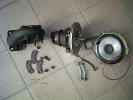 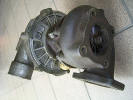 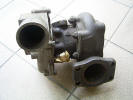
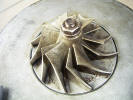 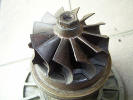 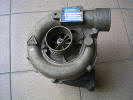
It's a KKK brand turbo charger. When I opened it up, lots of dirt came out. Now the blades turn a bit better. I seriously need to clean this up but I'll need to find time for that.
I might just use this turbo charger to build my OWN jet engine, separate from the SMP jet engine. As such, I will name this project the GXR-1 jet engine. GXR stands for: Guangyan eXperimental Research 1 - Jet Engine. I'm calling it that because it'll be easier to refer to the project, and besides, it sounds nice. Until next time!
Project Status - Paused indefinitely at the moment due to lack of funds (2005)
Back to main page
(c) Gao Guangyan 2011
Contact: loneoceans [at] gmail [dot] com |

